AEC Input
Acoustic Echo Cancelling (AEC) Inputs provide support for distance conferencing applications.
Initialization Dialog
When the AEC Input component is selected from the Audio Object Toolbar, an AEC Initialization dialog is produced.
Users can choose Autoconfigure to allow the software to allocate it to hardware, or choose to manually assign it to a Server, Rack-mount Expander (EX-MOD with EEC-4 card), Remote Expander (EX-AEC) or TesiraFORTÉ.
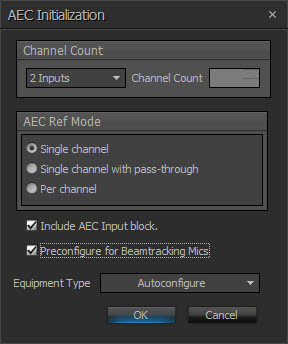
| Name | Description |
| Channel Count | Provides a dropdown where the number of channels can be selected. If Custom is selected from the drop-down list the number of channels can be specified between 1 and 24. |
| AEC Ref Mode | Determines how the AEC Reference block will be displayed and operate
|
| Include AEC Input Block | Specifies whether both the Input and AEC blocks are created (checked) or only the AEC block (unchecked). |
| Preconfigure for Beamtracking Mics | Optimizes AEC settings for use with Beamtracking microphones. |
| Equipment Type | Defines the type of hardware for this AEC input. Select Autoconfigure, SERVER, FORTÉ, Rack-mount Expander (EX-MOD with EEC-4 card), or Remote Expander (EX-AEC). |
NOTE: for more information regarding the configuration of Beamtracking microphones, see Parlé Best Practices.
DSP Block Representation
The AEC functionality is comprised of an input block, an AEC processing block and a reference block.

- AEC Input - contains the microphone preamp settings for the ambient sensing input and has one output connection per channel.
- AEC Processing Block - The AEC processing block has the signal processing functionality.
- AEC Ref- The AEC Reference block is used to tell the AEC process what signal to remove from the mic input.
The three blocks will have a number on the lower left, assigned by the software, which indicates which blocks are associated with each other, which is important when there are multiple AEC Inputs in the system.

When preconfigured for Beamtracking microphones, a "BT" will be shown in the lower right corner of the AEC channel block. Beamtracking defaults may be reset from the context menu of the AEC block by right-clicking and selecting "Reset to Beamtracking Defaults."

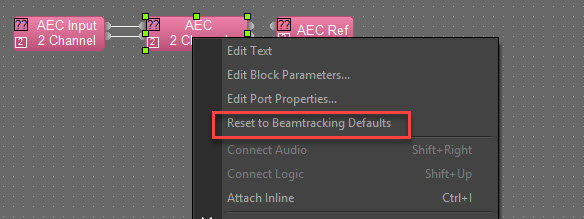
Remote AEC
The input and processing block can be separated, so the AEC processing feature can be used with non-AEC inputs, such as digital audio inputs from the network. In this instance, the input block could still be used to bring
analog mic or line inputs into Tesira, without the AEC processing function.
Only Inputs (Standard, Dante, AVB or CobraNet), Routers, Split Pass-Throughs and Partition Connectors may be connected to the AEC Processing block for acoustic echo cancelation on the audio signal. Support for Routers
connected pre-AEC processing objects was introduced in software version 3.1.

Expander AEC
Tesira version 2.1 and later introduces Expander and EX-MOD based AEC processing. The allocation of these processing blocks to a system can be achieved through the Equipment Type filter in the Initialization Dialog or
by adding Expander devices to the equipment table and using the property sheet to fix the AEC blocks in unit.
Control Dialog
AEC Input
Double clicking on the AEC Input block produces a control dialog window.
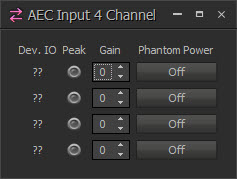
|
Name |
Description |
Range |
|
Device IO |
Indicates which physical hardware input is associated with that software channel. For SERVER and SERVER-IO devices is formatted as x.y - where x indicates which card slot and y indicates which channel on the card. |
|
|
Peak |
a software indicator that flashes when the input signal is within 3dB of clipping. |
|
|
Gain |
sets the amount of analog gain for that channel and is used to compensate for differing input levels (mic or line). |
0-66 in 6dB steps |
|
Phantom Power |
assigns +48 Volt phantom power to the input for use with condenser microphones |
On or Off |
AEC Processing Block
Double clicking on the AEC processing block produces a control dialog window.

| Name | Description | Range |
| Device IO | Indicates which physical hardware input is associated with that software channel. For SERVER and SERVER-IO devices is formatted as x.y - where x indicates which card slot and y indicates which channel on the card. | |
| AEC | Enables and disables the AEC processing chain. | |
| NLP Level |
Non-Linear Processing (NLP) is a stage of the Acoustic Echo Cancelation (AEC) process designed to eliminate residual echo in reverberant rooms with high RT60 times.
While setting NLP 'high' may reduce echo in these rooms, it has a negative effect on double talk. Typically the lowest possible NLP setting to eliminate echo achieves the best system performance.
A good practice is to start with a low setting and work upwards till echo can be no longer heard. |
|
| Noise Reduction | This reduces steady-state background noises, such as HVAC systems, fans, motors, or other mechanical devices, that may be picked up by the conferencing microphones and transmitted to the far end. Use the lowest setting that achieves the desired level of background noise reduction. |
|
| Mute | Turns the input signal on/off. | On or Off |
| Level | Adjusts the relative input volume. | -100 to +12 |
| Invert | Adjusts the polarity of the input signal. | 0° or 180° |
| Copy channel | Allows bulk copy from one channel to all channels in an AEC block, including properties in the Control Dialog and AEC Advanced dialog. Does not copy Mute or Level. |
AEC Channel Processing
Each channel of AEC has a Ch Processing button, which opens up a control dialog window.
Meters
The Meters tab gives information about how the AEC process is functioning.
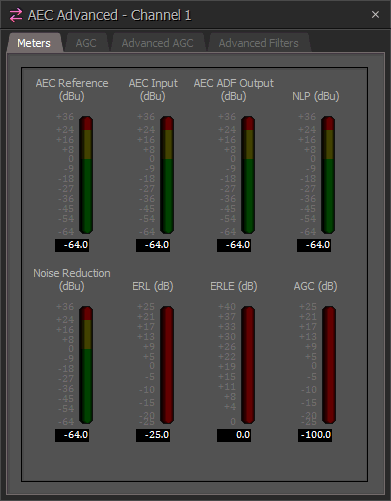
| Name | Description |
| AEC Reference | shows the signal level at the channel’s AEC Reference input, and should nominally read 0dBu. |
| AEC Input | shows the signal level at the AEC filter input and should nominally read 0dBu. |
| AEC ADF Output | shows the signal level at the output of the adaptive filter (ADF) that performs most of the echo cancellation. This should report a somewhat lower signal level than the AEC Input, since some signal components will have been removed. |
| NLP | shows the signal level after the Non-Linear Processing filter. |
| Noise Reduction | shows the signal level at the output of the Noise Reduction Filter. |
| ERL (Echo Return Loss) | shows the difference in level between signal components arriving at the AEC reference and those same signal components arriving at the AEC input after having been introduced into a physical space and picked up by the microphone. Since these signal components will be attenuated somewhat by air absorption, ERL will normally indicate a positive amount of loss. If ERL is too positive or in the negative range, it may indicate a gain structure problem. |
| ERLE (Echo Return Loss Enhancement) | shows the amount of echo reduction the AEC adaptive filter is doing. It is the difference in level between echo components arriving at the filter's inputs and the residual echo remaining at the output of the filter |
| AGC (Automatic Gain Control) | shows the amount of gain or attenuation being applied to the input signal. |
AGC
The AGC and AGC Advanced tabs show the settings for the Automatic Gain Control feature built in to the AEC input card. The functionality is identical to the ACG component object in the Dynamic Blocks menu of the Object Toolbar.

| Name | Description |
| Input Level | This meter shows the level of the input signal. |
| Target Level | Defines the signal level that the AGC block will constantly strive to output. If the input level is higher than the target level, the AGC block will subtract gain. If the input level is lower than the target level, the AGC block will add gain. |
| Minimum Threshold | The minimum input signal level required for the AGC to make adjustments. The maximum value for the Minimum Threshold will be the Target Level. If the input signal level is lower than the minimum threshold, the AGC block will temporarily suspend gain adjustments. |
| Gain | Shows how much gain is currently being added or subtracted from the input signal. |
| Limiter Active | Will light when the clip limiter is actively engaged in preventing clipping. |
| AGC Active | Will light when the AGC block is making a gain adjustment. |
| Hold Time | Is the number of seconds that the AGC block will hold the current Gain setting while not receiving a qualifying input signal. After the Hold Time elapses, the AGC block will reset the gain to zero. |
| Maximum Gain | Defines the maximum amount of gain that the AGC block will add to the signal. |
| Maximum Attenuation | Defines the maximum amount of gain that the AGC block will subtract from the signal. |
| Maximum Gain Adjustment Rate | Defines how quickly the AGC block can adjust the gain, specified in decibels per second. |
| Limiter On/Off | Turns the clip limiter feature on or off. When the clip limiter is on, the AGC will temporarily reduce the gain applied to the input signal if that gain would have caused the signal to clip. Gain adjustments made by the clip limiter may briefly exceed the Maximum Gain Adjustment Rate as necessary to prevent clipping. |
| Speech On/Off | Turns SpeechSense™ technology on or off. When Speech mode is on, the AGC analyzes the input signal to determine if it is human speech. Non-speech signals will not cause the AGC to adjust the gain when Speech mode is on. |
Qualifying Input SignalsThe AGC block will only adjust its gain when it receives a qualifying input signal. The definition of a qualifying input signal depends on whether Speech mode is on or off. When the input signal is not a qualifying signal, the AGC block will hold its previous gain setting until it receives a qualifying signal or until the Hold Time elapses. When Speech mode is ON, a qualifying signal must satisfy ALL of the following:
When Speech mode is OFF, a qualifying signal must satisfy the following:
|
Advanced AGC
The AGC and AGC Advanced tabs show the settings for the Automatic Gain Control feature built in to the AEC input card. The functionality is identical to the ACG component object in the Dynamic Blocks menu of the Object Toolbar.

| Name | Description |
| Input Level | Shows the level of the input signal. |
| Noise Floor | The meter shows the estimated level of the noise floor of the input signal. The Noise Floor is used in calculating the Signal-to-Noise Ratio. |
| SNR | The meter shows the Signal-to-Noise Ratio of the input signal. This is equal to the Noise Floor level subtracted from the Input Level. In general, the closer the talker is to the microphone, the higher the Signal-to-Noise Ratio will be while they are talking. |
| Minimum SNR | Determines how high the Signal-to-Noise Ratio (SNR) must be before the AGC will make gain adjustments. If the SNR is below the minimum, the AGC will temporarily suspend gain adjustments. |
Advanced Filters
The Advanced Filters tab shows settings for two pre-AEC filter stages.
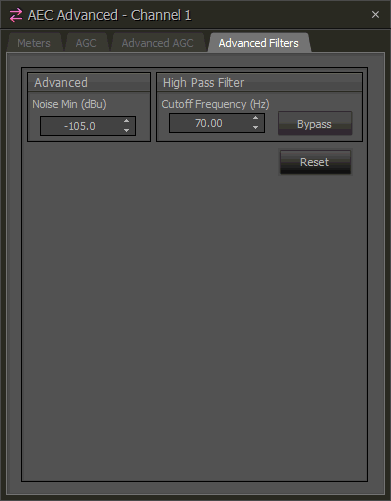
| Name | Description |
| Noise Min | Defines the level at which the AEC will start converging |
| Cutoff Frequency | Attenuates input signal components below a programmable Cutoff Frequency. Values in the range of 20Hz to 500Hz can be set. The filter is an elliptic 5th order design which attenuates frequencies below the cutoff at a slope of 30 dB/octave. |